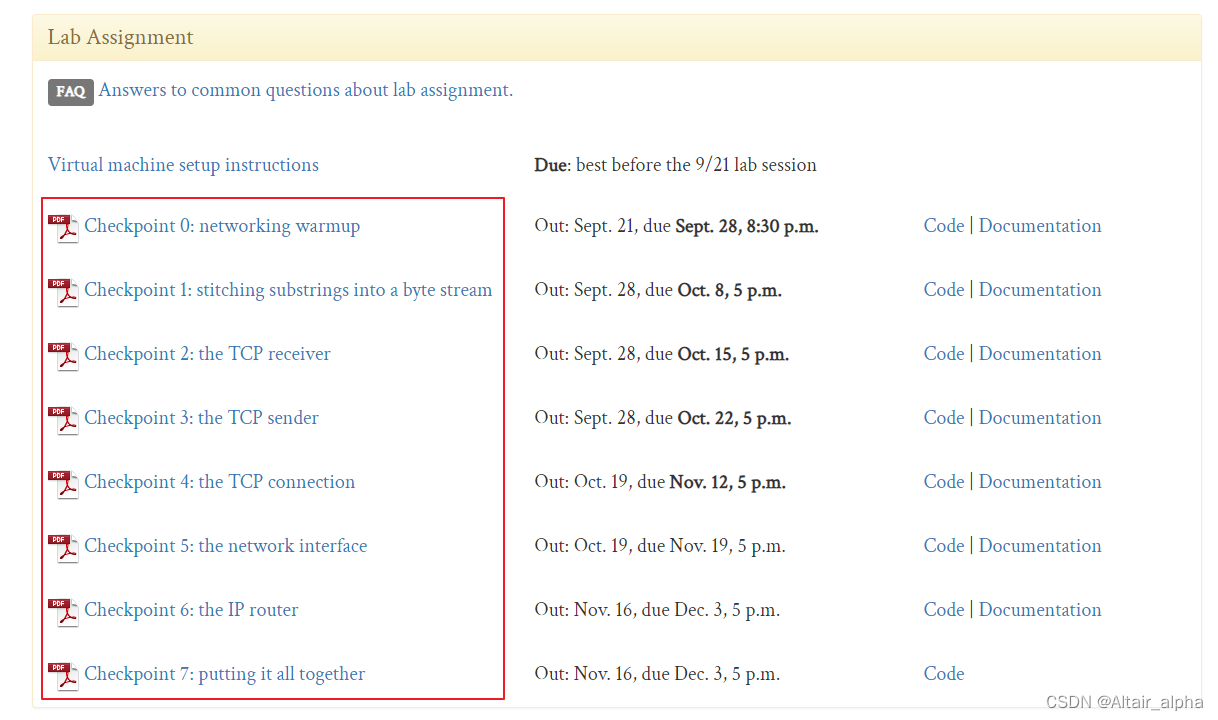【斯坦福计网CS144项目】环境配置 & Lab0: ByteStream
前言感觉学了不少 C++ 编程的知识和技术但比较缺少实践,于是打算找一些项目跟着做一做。首先安利一个自学网站 CS自学指南,北大的同学做的,汇总了很多国内外高校 CS 相关的高质量公开课,其中大部分是有课程项目的。翻了翻感觉 Stanford 的这门 CS144 计网课的 Lab 比较有趣,难度也不错,就是它了!课程网址:CS 144: Introduction to Computer Netwo
前言
感觉学了不少 C++ 编程的知识和技术但比较缺少实践,于是打算找一些项目跟着做一做。
首先安利一个自学网站 CS自学指南,北大的同学做的,汇总了很多国内外高校 CS 相关的高质量公开课,其中大部分是有课程项目的。翻了翻感觉 Stanford 的这门 CS144 计网课的 Lab 比较有趣,难度也不错,就是它了!
课程网址:CS 144: Introduction to Computer Networking
我跟的是 2021 Fall 学期的版本。
我的 Github 项目:CS144-Lab,7个实验的完成版代码位于 libsponge/ 文件夹内。
准备工作

在上面的网站中先把 8 个实验的文档(红框)下载下来,然后按上图中 Virtual machine setup instructions 链接开始设置虚拟机环境。推荐使用方法一:VirtualBox + 课程组准备好的 Ubuntu 镜像,跟着这个链接的步骤做就可以。设置共享文件夹那步建议完成。
完成后得到的是一个控制台界面的 Ubuntu 18.04 系统。该虚拟机已经设置好可以通过ssh连接(localhost:2222 端口),为了方便开发,可以用 PuTTY 连接打开多个窗口,配置如下(建议保存成 session,每次直接加载):


因为没有图形界面,开发工具自然是用 Vim,如果对 Vim 操作不熟练(比如博主自己ww)正好是个不错的锻炼机会。如果完全没有接触过 Vim,可以看 MIT 的 Missing Semester 中 Editors (Vim) 这课入门。关于 Vim 环境的配置,个人还是比较建议装一些插件(如语法高亮、代码补全等)改善开发体验,我的 .vimrc 如下,主要使用了 Vundle 插件管理,Molokai 主题,YouCompleteMe 代码分析补全还有 Vim 自带的显示行号等基本功能。Vim 的很多插件可以在这个网站上淘到。如果有需要以后也可以写一篇文章记录这个配置过程。

Lab 0
因为计网的知识大三都学过,做完以上准备工作就可以愉快地开始实验了。Lab 0 的第二部分 Networking by hand 和第三部分 Writing a network program using an OS stream socket 都比较简单,跟着文档说明一步步做就好,这里直接看第四部分 An in-memory reliable byte stream。
本节要求我们实现一个可靠的字节流(Byte Stream)类,reader/writer 分别能够从一端读出数据,一端写入数据,同时要控制流中数据任意时刻不能超过某个容量(capacity)值。这里无需考虑多线程使用读写锁等问题。需要实现的 public 函数已经定义好,实现时可以补充任意私有成员。
待完成的代码在 sponge/libsponge 目录内,完成后在 sponge/build 目录中执行 make (-j4/-j8) 编译,然后执行 make check_lab0 以运行自动测试,如果看到 100% tests Passed 则说明通过(t_webget 需要连接国外网站,耗时较长或超时都没关系)。如果需要运行单个测试,执行 ctest -R 测试名,测试名就是运行所有测试时输出的 Test #1: t_xx 中的 t_xx,然后根据提示信息可以查看单次测试的输出日志(注意:如果要用打印语句 Debug,用 cerr 而不是 cout 输出)。以后的实验都是如此,不再重复。
回到本次任务,要求还是比较简单的,选用一个数据结构存储数据流并维护一些状态信息即可,我这里用的是 deque<char>。容器的操作等实现细节上注意尽量用 Modern C++ 的风格。
ByteStream.hh:
#ifndef SPONGE_LIBSPONGE_BYTE_STREAM_HH
#define SPONGE_LIBSPONGE_BYTE_STREAM_HH
#include <deque>
#include <string>
//! \brief An in-order byte stream.
//! Bytes are written on the "input" side and read from the "output"
//! side. The byte stream is finite: the writer can end the input,
//! and then no more bytes can be written.
class ByteStream {
private:
// Your code here -- add private members as necessary.
// Hint: This doesn't need to be a sophisticated data structure at
// all, but if any of your tests are taking longer than a second,
// that's a sign that you probably want to keep exploring
// different approaches.
std::deque<char> _buf{};
std::size_t _capacity;
std::size_t _bytes_written = 0;
std::size_t _bytes_read = 0;
bool _input_ended = false;
bool _error = false; //!< Flag indicating that the stream suffered an error.
public:
//! Construct a stream with room for `capacity` bytes.
ByteStream(const size_t capacity);
//! \name "Input" interface for the writer
//!@{
//! Write a string of bytes into the stream. Write as many
//! as will fit, and return how many were written.
//! \returns the number of bytes accepted into the stream
size_t write(const std::string &data);
//! \returns the number of additional bytes that the stream has space for
size_t remaining_capacity() const;
//! Signal that the byte stream has reached its ending
void end_input();
//! Indicate that the stream suffered an error.
void set_error() { _error = true; }
//!@}
//! \name "Output" interface for the reader
//!@{
//! Peek at next "len" bytes of the stream
//! \returns a string
std::string peek_output(const size_t len) const;
//! Remove bytes from the buffer
void pop_output(const size_t len);
//! Read (i.e., copy and then pop) the next "len" bytes of the stream
//! \returns a string
std::string read(const size_t len);
//! \returns `true` if the stream input has ended
bool input_ended() const;
//! \returns `true` if the stream has suffered an error
bool error() const { return _error; }
//! \returns the maximum amount that can currently be read from the stream
size_t buffer_size() const;
//! \returns `true` if the buffer is empty
bool buffer_empty() const;
//! \returns `true` if the output has reached the ending
bool eof() const;
//!@}
//! \name General accounting
//!@{
//! Total number of bytes written
size_t bytes_written() const;
//! Total number of bytes popped
size_t bytes_read() const;
//!@}
};
#endif // SPONGE_LIBSPONGE_BYTE_STREAM_HH
ByteStream.cc:
#include "byte_stream.hh"
using namespace std;
ByteStream::ByteStream(const size_t capacity) : _capacity(capacity) {}
size_t ByteStream::write(const string &data) {
if (_input_ended) {
return 0;
}
size_t write_len = min(data.size(), remaining_capacity());
_buf.insert(_buf.end(), data.begin(), data.begin() + write_len);
_bytes_written += write_len;
return write_len;
}
//! \param[in] len bytes will be copied from the output side of the buffer
string ByteStream::peek_output(const size_t len) const {
size_t peeked_len = min(len, _buf.size());
return string(_buf.begin(), _buf.begin() + peeked_len);
}
//! \param[in] len bytes will be removed from the output side of the buffer
void ByteStream::pop_output(const size_t len) {
size_t popped_len = min(len, _buf.size());
_buf.erase(_buf.begin(), _buf.begin() + popped_len);
_bytes_read += popped_len;
}
//! Read (i.e., copy and then pop) the next "len" bytes of the stream
//! \param[in] len bytes will be popped and returned
//! \returns a string
string ByteStream::read(const size_t len) {
if (len == 0) {
return "";
}
string res = peek_output(len);
pop_output(res.size());
return res;
}
void ByteStream::end_input() { _input_ended = true; }
bool ByteStream::input_ended() const { return _input_ended; }
size_t ByteStream::buffer_size() const { return _buf.size(); }
bool ByteStream::buffer_empty() const { return _buf.empty(); }
bool ByteStream::eof() const { return input_ended() && buffer_empty(); }
size_t ByteStream::bytes_written() const { return _bytes_written; }
size_t ByteStream::bytes_read() const { return _bytes_read; }
size_t ByteStream::remaining_capacity() const { return _capacity - _buf.size(); }
最后贴张通关图 😎

更多推荐
 已为社区贡献1条内容
已为社区贡献1条内容









所有评论(0)